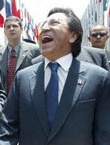THE COCA LEAF: FACTS AND FICTIONS
by MICHAEL TOAL
This
article is published with the permission of
ZNET.
*
* * * * * * * * *
Avarice
is not a fault inherent in gold, but in the man who
inordinately loves gold. Saint Augustine
Tear
gas rises in plumes from a crowd assembled on Cusco's busiest
street, Avenida del Sol, directly across from the Inca and colonial
Spanish ruins of Qorikancha. Today, Peru's cultural capital is
not the Machu Picchu paradise expected by most tourists.
A group
of twenty policemen drag a shirtless youth up the sidewalk. Following
them, a group of women shout, "Leave him! Where are you taking
him?" As the smoke begins to subside, panicked women, furious
students and crying young girls yell through their tears the story
of what had just happened to them. A group of Peruvian journalists
listen and record.
The people
on the street belong to an alliance of agricultural students and
cocaleros (rural coca growers) from Quillabamba, Cusco
department, protesting the government's refusal to allow them
to grow coca for traditional and medicinal use, something they
consider a human right. They took their problems to the streets
of Cusco, assuming they would be listened to by the state, which
would hope to avoid a spectacle in front of foreign tourists.
A puff of kef (hashish) in the morning gives the strength
of a 1000 camels. Moroccan proverb.
Across
the Andes, the coca leaf has been cultivated historically for
its medicinal properties. Indigenous Andeans and Limeños
alike affirm that chewing coca leaves or drinking coca tea helps
to alleviate the affects of altitude sickness, a common problem
in the Andes, as well as to quell hunger pains and general tiredness.
The
Peruvian cocalero has made the country the world's
leader in coca leaf production.
It
was the coca leaf used by forced Andean laborers -- stolen from
their lands by the Spanish colonialists -- that helped in the
clearing out of Bolivia's famous Potosi mine, subsequently lining
the pockets of their European oppressors with a mountain of
silver.
With
coca in their mouths, entering their systems through their saliva,
the miners could survive their long unfed hours in the depths
of the mountain -- a reprieve that would last until they died
from their labors after a mere ten years of work.
Before
the conquest, the coca leaf was used by the Incas in rituals
for hundreds of years. In regions like Cusco, the coca leaf
has no other use than for ritual and medicine. The other, more
popularly known use and abuse of coca has forced the people
of this region to remind the world, through selling of T-shirts
to tourist, that "the coca leaf is not a drug."
Indeed
it is not.
The coca
leaf does not become cocaine until it is ground into a paste and
put through a complex chemical process. It its raw, natural form
it does not possess anywhere near the same potency as cocaine.
Unfortunately
for the people from Quillabamba, the US anti-drug policy -- this
so-called "war on drugs" -- does not make this connection.
Peruvian coca leaves are being exported to Colombia where they
are processed into cocaine and shipped to western markets.
The policy
is dead-wrong in targeting the fields of Quillabamba when everyone
knows that the coca heading to Colombia is produced in the Upper
Huallaga Valley, Satipo, and the Rio Ene (in the Peruvian lowlands
and along the Colombian border, nowhere near Cusco) under the
close supervision of former Shining Path guerrillas and other
interested parties.
The US
policy of crop eradication through indiscriminate chemical spraying
is destroying the honest livelihood of thousands of Peruvian campesinos,
who are already living in severe conditions of poverty. These
crop-spraying missions have the same sort of accuracy we have
witnessed recently in Afghanistan and Iraq. In short, US planes
are spraying with chemicals the same fields that are meant to
nourish an undernourished Andean population.
 It
is a common belief in the region that the anti-coca campaign of
the Alejandro Toledo government has been written in Washington.
Are we surprised that President Toledo is enjoying a typically
Latin American 90% disapproval rating. Toledo, the Quechua-speaking,
shoe-shine boy who became president, has failed all of Peru's
poor who must live with US policy in their fields and Toledo’s
law-and-order boys their towns and villages.
It
is a common belief in the region that the anti-coca campaign of
the Alejandro Toledo government has been written in Washington.
Are we surprised that President Toledo is enjoying a typically
Latin American 90% disapproval rating. Toledo, the Quechua-speaking,
shoe-shine boy who became president, has failed all of Peru's
poor who must live with US policy in their fields and Toledo’s
law-and-order boys their towns and villages.
On the
street outside of Qoricancha, a young woman sobs to the media,
explaining that she was hit in the face by a tear-gas canister.
She adds defiantly that she and the cocalero group will
not leave the street until their seven companions -- missing in
the confusion of the police crackdown on the peaceful march --
are released unharmed from the hands of a police force in the
service of the US government.